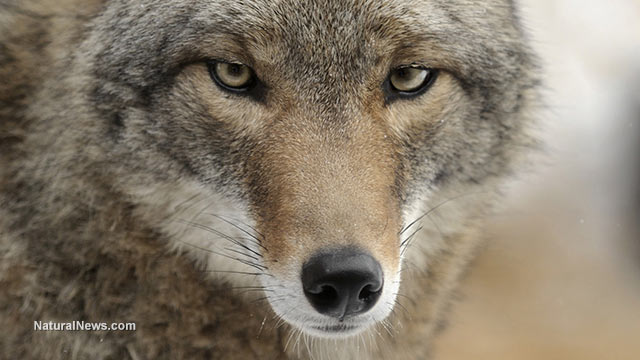Coyotes on psychedelic mushrooms are staring down and attacking cars
Tuesday, February 09, 2016 by: L.J. Devon, Staff Writer
Tags: fly agaric mushroom, coyotes, strange behavior

(NaturalNews) The Marin Humane Society of Western Nevada County, California, has been fielding calls concerning coyotes that are staring down cars and approaching passersby off Highway 1. The strange coyote behavior has been the talk of the county, especially at Beth's Community Kitchen in the Bolinas area.
Several reports indicate that a coyote is staring down vehicles as they make their way through the twisting, turning section near the Slide Ranch turnoff. The coyote will then reportedly "attack" the car, before trotting back off into the wilderness.
Some drivers see the coyote coming in advance, and stop the car on the highway, trying not to hit it. The coyote reportedly sniffs around the vehicle and then takes off into the bush. One local says the coyote stare-down has become a routine experience as he makes his way to the airport each week.
Lisa Bloch, director of marketing and communications for the Marin Humane Society says, "We are trying to figure this out." Some fear that the coyotes have rabies. "If this is going on longer than a week or so, then it's likely not rabies," says Bloch. "And we don't suspect rabies, just because it is pretty rare."
One possible scenario is that the coyotes are being fed by someone who drives on the highway frequently. Bloch says, "It's possible that someone was feeding him and thinking that it's cool, and magical and mystical to have a coyote eating out of his hand." One would think the coyotes would give up after unsuccessfully stalking several vehicles.
Another plausible scenario is that the coyotes are eating the hallucinogenic fly agaric mushroom (amanita muscaria), and acting out of character as a result. Lisa Bloch hasn't ruled it out. The coyotes could be tripping on the mushrooms, and be more willing to interact with people passing by. Bloch has cautioned dog owners to watch their animals closely to make sure they aren't tripping on the fly agaric mushrooms. If the mushrooms are not dried properly, they can be toxic.
The state of California says there could be up to 750,000 coyotes living in the wilderness. According to Bloch, no one should interact with the wild animals. "What this means is that basically we want the animals to be afraid of us naturally," Bloch says. "If they are not afraid of us, they come close to our cars, get hit, fight with domestic dogs and can possibly become aggressive."
Past traditions celebrated closeness to wild animals and revered the fly agaric mushroom
Many of our Christmas traditions come from cultures that were close to wild caribou (reindeer), and the hallucinogenic use of the fly agaric mushroom. In ancient, snowy Siberia (close to the North pole), the northern Tungusic people (also known as the Evenki), worked together in close knit communities where they herded reindeer. The reindeer provided them with clothing, milk, housing material, tools, transportation and spiritual inspiration.The Evenki also believed in the shamanic journey or soul flight, and they used altered states of consciousness to connect with Spirit. One of the ways they celebrated this connection was through the fly agaric mushroom. The bright red and white to golden orange and yellow-capped mushrooms grow under certain kinds of evergreen trees. The amanita mushrooms possess psychoactive qualities, but are also very toxic if not dried properly.
Before gathering the mushrooms in sacks and carrying them back to the village on their reindeer-pulled sleds, shaman gatherers would dry the mushrooms out in the boughs of the evergreen trees. The colorful, rounded caps hanging in the trees must have inspired the modern day decoration of Christmas trees.
Oftentimes, the shaman would have to travel down villagers' individual chimneys to deliver the mushrooms, because the individual yurts were often snowed in. The Evenki would dry the mushrooms out further in socks that they hung next to the fireplace. The shaman would then demonstrate how to use the mushrooms for spiritual purposes. One of the common visions they experienced was flying. This is likely where the idea of flying and flying reindeer originated. (The also observed the reindeer eating the mushroom and then consuming their own pee.)
The original gifts under the Christmas tree were of spiritual nature – the fly agaric mushrooms. The Evenki's connection to the natural world and the wild reindeer goes beyond what we can fathom in modern day, consumerist America.
Sources include:
TheUnion.com
TruthTheory.com
PacificSun.com
Fly agaric mushroom at FETCH.news
Get independent news alerts on natural cures, food lab tests, cannabis medicine, science, robotics, drones, privacy and more.
Take Action: Support Natural News by linking to this article from your website
Permalink to this article:
Embed article link: (copy HTML code below):
Reprinting this article:
Non-commercial use OK, cite NaturalNews.com with clickable link.
Follow Natural News on Facebook, Twitter, Google Plus, and Pinterest
- STAMP OUT DEPRESSION and ANXIETY with these 10 key supplements that boost dopamine naturally
- Instead of adding PINK RIBBONS to products for "Cancer Awareness" month, companies should actually remove the ingredients that CAUSE cancer
- Careless Whisper: AI-powered transcription tool being used by hospitals found to invent chunks of text no one ever said
- Michael Yon warns of a ZIONIST TAKEOVER in Trump’s second administration
- Casual restaurant chain TGI Fridays files for BANKRUPTCY
- SPIKE PROTEIN COCKTAIL: UK launches "booster program" to combine covid shots with flu shots and require them every year
- A sovereign United States must oppose the World Health Organization and combat human exploitation in healthcare
- Hyssop essential oil: Ancient healing herb in modern form
- Kari Lake reportedly under consideration to be the next U.S. ambassador to Mexico
- Could GMO crops be the MAIN REASON for the explosion of LEAKY GUT SYNDROME?
- HYSSOP: What research reveals about the health benefits of this ancient holy herb
- Four Palestinian journalists killed in Gaza airstrike, death toll of journalists reaches 182
- Trump says EVERYONE on the January 6th "Committee" could face jail time for lies and deception that has hundreds of innocent protesters suffering and dying in DC gulags
- Top 8 TELL-TALE SIGNS the U.S. Government is LYING about the "mysterious" DRONES
- Jews rejecting CHRIST: Israel wants family of Christian soldier who died in Gaza to remove the “CROSS” from his headstone
- Economic crisis: Americans are unprepared for the coming collapse
- 10 Habits all preppers follow
- Critics denounce Canada’s addition of 300 “assault-type” firearms to the list of prohibited weapons
- Michael Yon warns of a ZIONIST TAKEOVER in Trump’s second administration
- Trump says EVERYONE on the January 6th "Committee" could face jail time for lies and deception that has hundreds of innocent protesters suffering and dying in DC gulags
- Careless Whisper: AI-powered transcription tool being used by hospitals found to invent chunks of text no one ever said
- Chinese submarines can now track AND SINK U.S. Navy aircraft carriers
- Casual restaurant chain TGI Fridays files for BANKRUPTCY
- Fermented green tea is a novel functional food that can help reduce obesity and regulate triglyceride levels
- Instead of adding PINK RIBBONS to products for "Cancer Awareness" month, companies should actually remove the ingredients that CAUSE cancer
- Four Palestinian journalists killed in Gaza airstrike, death toll of journalists reaches 182
- Critics denounce Canada’s addition of 300 “assault-type” firearms to the list of prohibited weapons
- Humiliation campaign: Israel arrests Palestinians in West Bank, writes number on their foreheads
- Jews rejecting CHRIST: Israel wants family of Christian soldier who died in Gaza to remove the “CROSS” from his headstone
- Kari Lake reportedly under consideration to be the next U.S. ambassador to Mexico
- The so-called “Star of David” is actually the Babylonian symbol of Remphan, according to the Bible
- Texas AG Ken Paxton files lawsuit against El Paso pediatrician for illegally prescribing gender transition drugs and therapies to minors
- Traitor Trudeau to freeze all handgun sales in Canada in latest act of WAR against citizens
- Trump picks rabid, pro-censorship Zionist Kristi Noem to head Homeland Security - will she arrest Americans who criticize Netanyahu?
- CEO's murder sparks security scramble in greed-driven healthcare industry
- SPIKE PROTEIN COCKTAIL: UK launches "booster program" to combine covid shots with flu shots and require them every year
- Michael Yon warns of a ZIONIST TAKEOVER in Trump’s second administration
- Texas AG Ken Paxton files lawsuit against El Paso pediatrician for illegally prescribing gender transition drugs and therapies to minors
- BBC staffers accuse media outlet’s executives of instituting bias in Gaza coverage, claiming favorable treatment of Israel
- Casual restaurant chain TGI Fridays files for BANKRUPTCY
- HYSSOP: What research reveals about the health benefits of this ancient holy herb
- Humiliation campaign: Israel arrests Palestinians in West Bank, writes number on their foreheads
- West not taking seriously enough the threat of a nuclear attack by Moscow, warns former Russian president
- Former Israeli PM Ehud Olmert says Netanyahu is the real enemy - not Iran or Hezbollah
- Instead of adding PINK RIBBONS to products for "Cancer Awareness" month, companies should actually remove the ingredients that CAUSE cancer
- Judge rules against AstraZeneca for breaching COVID “vaccine” contract with trial participant injured by experimental jab
- Bombshell US House investigative report confirms that almost everything the alternative media said about COVID origins, lockdowns, masks, vaccines and government overreach was TRUE
- Social media censorship in the EU about to go into overdrive with upcoming new rules against “disinformation”
- Democrats say Trump planning to throw them in concentration camps - this after calling for Republicans to be “reeducated” in gulags
- Steve Bannon issues 90-second WARNING to deep state at Trump victory party
- Pentagon: U.S. ready to support South Korea with NUCLEAR WEAPONS
- Bill Barr: All cases against Trump must be dropped IMMEDIATELY
- Mike Flynn and Steve Bannon outline potential strategy for Trump's return to office
- Biden-Harris administration spent over $900 million to promote COVID-19 vaccines
- Red Cross issues warning to stop blood plasma donations from vaccinated people
- Heavily CENSORED Pfizer documents show that COVID began a five-year mass DEPOPULATION agenda that will reach completion by 2025
- DATA: England’s vaccinated population had close to one million deaths in 23 months; unvaccinated population had less than 61,000 deaths over the same period
- Scientists confirm: GENIUS brain function can be spontaneously unleashed in humans without any apparent cause
- Arizona residents drive entire Maricopa County Board of Supervisors out of meeting after serving them for TREASON
- Today I asked our AI language model “Neo” about which phytonutrients or phytochemicals can block the spike protein related to SARS-CoV-2 … Here is what it answered…
- Fully vaccinated about to see “tsunami” of illness and death, warns virologist
- BREAKING: 2025 NDAA authorizes mandatory military draft of WOMEN across America… as Pentagon pursues global NUCLEAR war with both Russia and China at the same time
- Former Bill Gates vaccine scientist predicts sharp population decline: “up to 30-40% in highly vaccinated countries”
- We are building the infrastructure of human freedom… Brighteon.AI is the next launch that will put life-altering LLM technology into your hands for free
- NASA admits that climate change occurs because of changes in Earth’s solar orbit, and NOT because of SUVs and fossil fuels
- ENGINEERED FAMINE: Oregon starts SHUTTING DOWN small farms “to protect the people”
- 5G REMOTE KILL VECTOR: Science paper reveals cell phone signals can activate the release of biological PAYLOADS from graphene oxide injected into the body
- These 13 countries just signed an agreement to engineer a global FAMINE by destroying food supply
- Ozempic and Wegovy weight loss drugs are injectable LIZARD VENOM PEPTIDES that may unleash a devastating wave of organ failure… side effects align with symptoms of SNAKE BITES
- Emergency whistleblower: RED DAWN ALERT – South American violent CRIMINALS dispersed across U.S. cities in run-up to 2024 CHAOS
- Spin-off DISEASE: Fully vaccinated for COVID manifesting new disease called VEXAS syndrome
- Getting vaccinated for covid four or more times results in near-complete collapse of the immune system, bombshell study finds
Science News & Studies
Medicine News and Information
Food News & Studies
Health News & Studies
Herbs News & Information
Pollution News & Studies
Cancer News & Studies
Climate News & Studies
Survival News & Information
Gear News & Information
News covering technology, stocks, hackers, and more



"Big Tech and mainstream media are constantly trying to silence the independent voices that dare to bring you the truth about toxic food ingredients, dangerous medications and the failed, fraudulent science of the profit-driven medical establishment.
Email is one of the best ways to make sure you stay informed, without the censorship of the tech giants (Google, Apple, Facebook, Twitter, YouTube, etc.). Stay informed and you'll even likely learn information that may help save your own life."
–The Health Ranger, Mike Adams












































